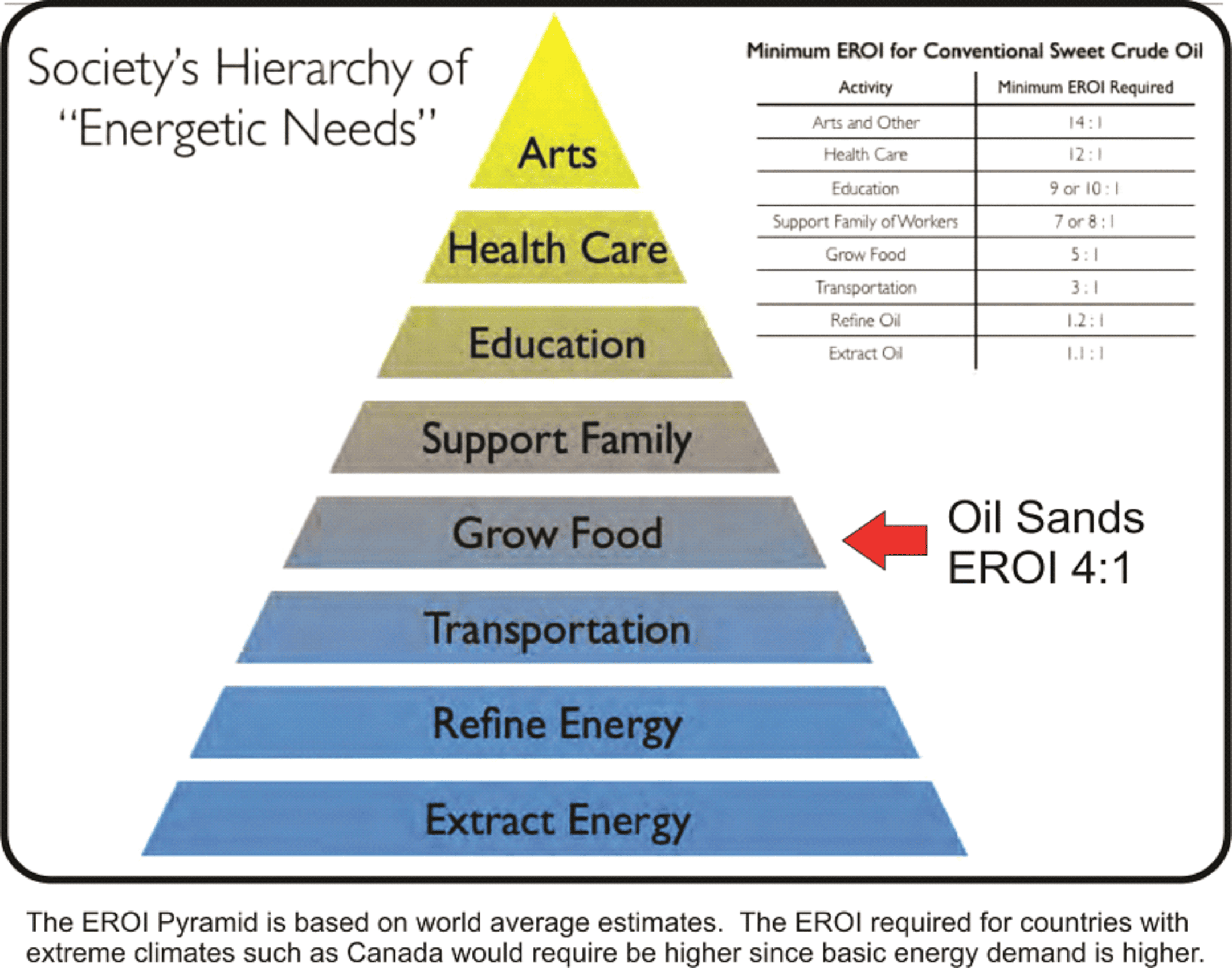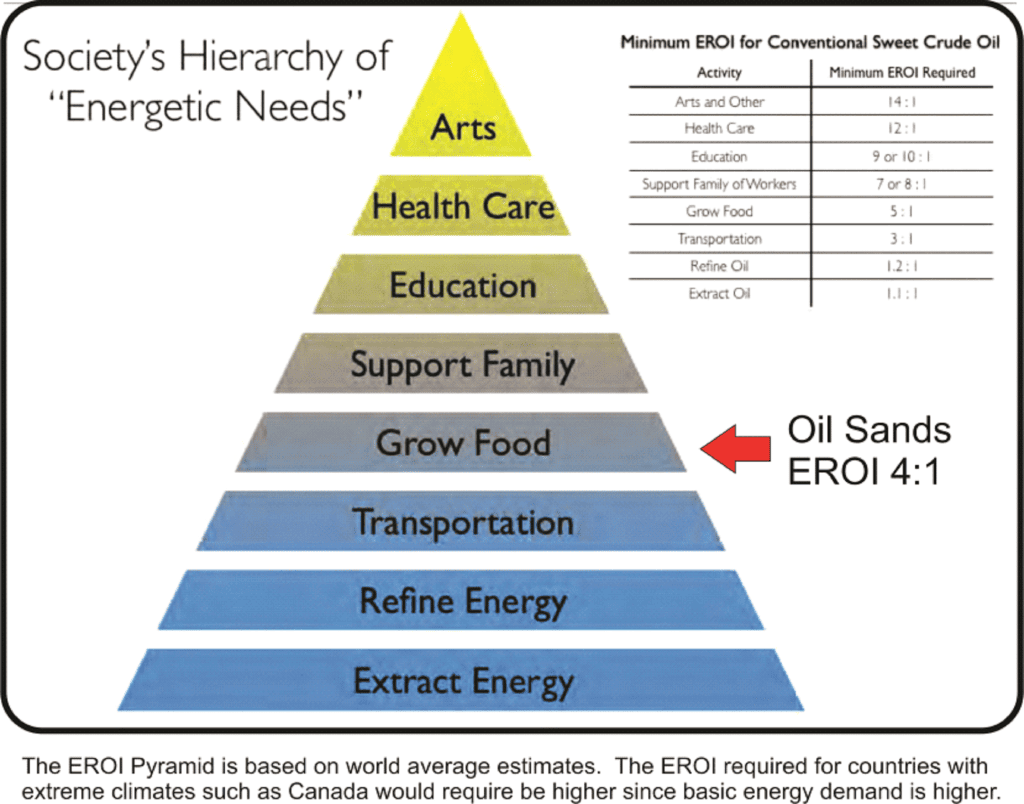With world oil resources depleting, it is often heard that “Canada will be OK!” because we have the oil sands, a 165 billion barrel ($13 trillion @ $80/bbl1) resource that will look after Canadian requirements for over a century.
There are two problems with this. The first is that Canadian consumers pay the world price for oil and therefore any supply shortfall would increase prices enough to kill off demand to the point where it equals supply. Unless Canada adopted a “Canada First” policy, which is not likely since our oil companies are foreign owned, world conditions will determine the availability of fossil fuels in Canada.
The second problem is that even if Canada were to stop oil exports, our society would then be dependent on the most expensive and dirtiest source of oil with the largest legacy costs on the planet. But never mind the legacy clean-up cost question ranging from $60 billion to $260 billion depending on who you trust, for a moment. The costs are so high the oil sands are unlikely to ever be cleaned up and will remain the largest chemical wasteland in the world.
The critical aspect is EROI – Energy Returned on Energy Invested. This vital social metric illuminates energy efficiency; energy out per energy in. Our civilization has achieved its high level of sophistication, productive capacity and population size by exploiting the energy potential of extremely rich oil, coal and natural gas deposits over the last 400 years. These reserves are running out.

In the early days of huge virgin oil fields, where once penetrated, oil literally gushed out of the ground, EROIs could hit 100:1 meaning that for every 1 barrel equivalent of energy committed to oil production, 100 barrels were produced. In practical terms, the cost was next to nothing and the net energy yield was 99%.
But if the oil sands were the only resource one had to depend on instead of being part of a homogeneous market where oil is oil, then an oil dependent society would be in for a shock.
The worldwide average EROI for oil is currently around 15:1 and falling. To illustrate the impacts of declining EROI, let’s look at the circumstance of Bob from Regina who has to go out and harvest his own energy. We look at his experience and the implications for the prosperity of his community for three EROIs (levels of richness) of oil production.
Bob has to drive from Regina to the oil wells and the oil sands all assumed to be 1000 km from Regina.
Conventional virgin oil field – EROI of 100:1
Bob of Regina loads 1000 litres of gas in the truck and drives to a virgin wellhead.
- Arriving at the wellhead Bob applies all of his 1000 litres which yields an amount of oil equal to 100,000 litres of gas.
- He uses a small refinery he brought with him to refine the oil into gas
- 100,000 litres @ 85% efficiency = 85,000 litres of gas total net output
- Bob loads the 85,000 litres of gas on his impressive truck and drives back to Regina
- Bob’s impressive truck uses 20 litres of gas per 100km equalling 200 litres of gas each way for a total of 400 litres
- Net gasoline per trip 85,000 – 400 = 84,600 litres
- The round trip takes a week
Bob and his community can use this energy for transportation, food, heating, education, health, defense, material goods, housing plus recreation and lots of it.
He can also easily save the 1,000 litres of gas needed to go and get another 85,000 litres when the current supply runs out. The 84,000 litres he is free to spend lasts a long time, maybe a year, even with his carefree lifestyle.
Bob spends an insignificant amount of his time producing energy, maybe 1 week a year.
Current World oil – EROI 15:1
which roughly in the same ballpark as the current fracking EROI
Bob loads 1000 litres of gas in the truck and drives 1000 km to the fracking fields.
- He drills, fractures and sucks out oil equivalent to 15,000 litres of gas
- He uses a small refinery he brought with him to refine the oil into gas
- 15,000 litres @ 85% efficiency = 12,700 litres of gas total net output
- Bob loads the 12,700 litres of gas on his fair sized truck and drives back to Regina
- Bob’s fair sized truck uses 15 litres of gas per 100km equalling 150 litres of gas each way for a total of 300 litres
- Net gasoline per trip 12,700 – 300 = 12,400 litres
- Round trip with production takes 10 days
Bob can use this energy for necessities of food, heating and transportation. There is enough left over to support sophisticated education, science and health care. Defense, material goods, housing are maintained at significant levels and, with steady increases in efficiency, there is still a fair amount of recreation possible.
Social infrastructure on a national level can be maintained.
Saving the 1,000 litres of gas to support the next trip for fuel requires discipline but it can be done.
Therefore he has a total of 12,400 – 1,000 = 11,400 litres to live on in between trips. Trips will be spaced at about every 2 months.
Bob spends 15% of his time producing energy.
Oil Sands Mining – EROI of 4:1
Bob loads 1000 litres of gas in the truck and drives to Fort McMurray.
- He arrives at the oil sands and digs up and heats the sand to yield oil equivalent to 4,000 litres of gas
- He uses a small refinery he brought with him to refine the oil into gas
- 4,000 litres @ 85% efficiency = 3,400 litres of gas
- Bob loads the 4,000 litres of gas on his small truck and drives back to Regina
- Bob’s small truck uses 10 litres of gas per 100km equalling 100 litres of gas each way for a total of 200 litres
- Net gasoline per trip 4,000 – 200 = 3,200 litres
- Round trip with production takes 2 weeks
Bob can use this energy for the absolute bare necessities of food, heating and vital transportation. Maybe some education and basic health. Defense, material goods, housing are all kept to an absolute minimum. Recreation is zero. Energy this scarce requires that only the best and most fertile fields are farmed. The population adjusts itself accordingly.
Social infrastructure is very difficult to maintain and education, health, science, art decline to a local and then family level.
Bob struggles to save the 1,000 litres of gas to support the next trip for fuel. There is extreme pressure to eat his “seed grain”.
Therefore he has a total of 3,200 – 1,000 = 2,200 litres to live on in between trips. Trips will be much more frequent, perhaps more than once a month.
Bob spends almost half his time producing energy and likely a large proportion of the rest of his time producing food.
Studies have indicated to this point that the EROIs required to sustain sophisticated societies in northern and extreme climates exceed 8:1.
The oil sands will not support a sophisticated society in Canada.


